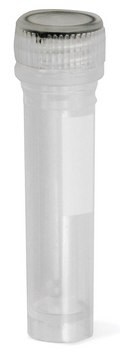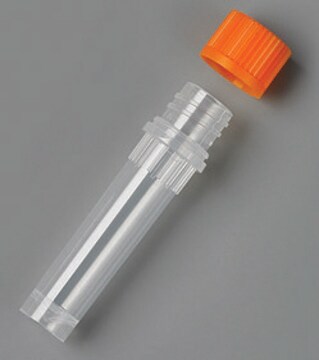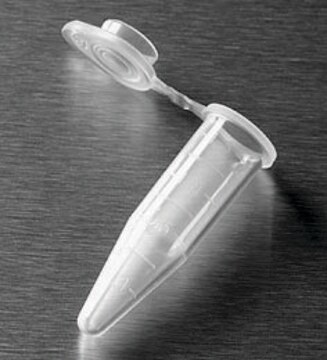CLS430909
Corning® microcentrifuge tubes with screw cap
1.5 mL microcentrifuge tube, polypropylene, w/ attached screw cap, w/ 0-ring, sterile, natural, 500/cs
Synonym(s):
centrifuge tubes, micrcentrifuge tubes, microfuge tubes, screw cap microcentrifuge tubes
About This Item
Recommended Products
material
conical bottom tube
natural polypropylene tube
screw top cap
description
O-ring (black silicone, rubber O-ring in cap)
sterility
sterile
feature
self-standing: no conical bottom
packaging
pack of 50
case of 500
manufacturer/tradename
Corning 430909
parameter
20000 × g max. RCF
cap diam.
12.7 mm
capacity
1.5 mL
tube O.D.
10.7 mm
color
natural
fitting
cap (screw cap)
Looking for similar products? Visit Product Comparison Guide
Related Categories
General description
- 1.5 mL polypropylene microcentrifuge tubes feature screw caps that provide a tight secure seal
- Attached cap with silicone O-ring
- Withstands a maximum RCF of 20,000xg
- Sterile
- Maximum RCF is 20,000
- No marking spot
Legal Information
Choose from one of the most recent versions:
Certificates of Analysis (COA)
It looks like we've run into a problem, but you can still download Certificates of Analysis from our Documents section.
If you need assistance, please contact Customer Support.
Already Own This Product?
Find documentation for the products that you have recently purchased in the Document Library.
Customers Also Viewed
Protocols
Reverse transcription (RT) is the process of converting RNA to cDNA using a reverse transcriptase enzyme and dNTPs.
Hot Start dNTPs are modified with a thermolabile protecting group at the 3’ terminus. The presence of this modification blocks nucleotide incorporation by DNA polymerase until the nucleotide protecting group is removed during a heat activation step.
The most common application for qPCR is the measurement of a gene transcript or copy number quantity relative to one or more reference genes using probe detection.
Perform reverse transcription (RT) using a reverse transcriptase enzyme and dNTPs. Use total RNA or a gene-specific approach so that only the RNA of interest is converted to cDNA.
Our team of scientists has experience in all areas of research including Life Science, Material Science, Chemical Synthesis, Chromatography, Analytical and many others.
Contact Technical Service










